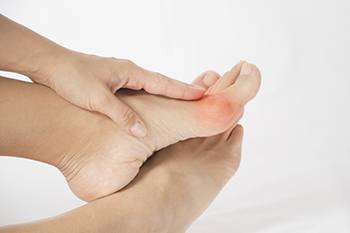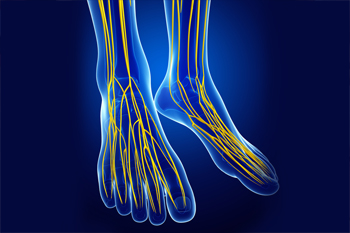Items filtered by date: September 2021
What Is Tarsal Coalition?
 Tarsal coalition is a condition in which two of the bones located at the back of the foot become attached to each other due to abnormal growth in the bones themselves, cartilage, or fibrous tissue. The abnormal growth creates a bridge between two bones and leads to foot pain, foot and ankle stiffness, flat feet, muscle spasms, and difficulty walking or limping. Tarsal coalition can be caused by a genetic abnormality, foot trauma, an infection, or arthritis. Most cases are genetic and present from birth, but don’t show symptoms until a child is around 10 years old and the bones have matured. Treatments for tarsal coalition include resting the affected foot, wearing orthotics, a cast, or boot, taking medications to relieve pain, and doing strengthening and stretching exercises. In some cases, surgery may be necessary. If you or your child is experiencing foot pain, please consult with a podiatrist.
Tarsal coalition is a condition in which two of the bones located at the back of the foot become attached to each other due to abnormal growth in the bones themselves, cartilage, or fibrous tissue. The abnormal growth creates a bridge between two bones and leads to foot pain, foot and ankle stiffness, flat feet, muscle spasms, and difficulty walking or limping. Tarsal coalition can be caused by a genetic abnormality, foot trauma, an infection, or arthritis. Most cases are genetic and present from birth, but don’t show symptoms until a child is around 10 years old and the bones have matured. Treatments for tarsal coalition include resting the affected foot, wearing orthotics, a cast, or boot, taking medications to relieve pain, and doing strengthening and stretching exercises. In some cases, surgery may be necessary. If you or your child is experiencing foot pain, please consult with a podiatrist.
Foot Pain
Foot pain can be extremely painful and debilitating. If you have a foot pain, consult with Matthew McQuaid, DPM from Lake Mendocino Podiatry. Our doctor will assess your condition and provide you with quality foot and ankle treatment.
Causes
Foot pain is a very broad condition that could be caused by one or more ailments. The most common include:
- Bunions
- Hammertoes
- Plantar Fasciitis
- Bone Spurs
- Corns
- Tarsal Tunnel Syndrome
- Ingrown Toenails
- Arthritis (such as Gout, Rheumatoid, and Osteoarthritis)
- Flat Feet
- Injury (from stress fractures, broken toe, foot, ankle, Achilles tendon ruptures, and sprains)
- And more
Diagnosis
To figure out the cause of foot pain, podiatrists utilize several different methods. This can range from simple visual inspections and sensation tests to X-rays and MRI scans. Prior medical history, family medical history, and any recent physical traumatic events will all be taken into consideration for a proper diagnosis.
Treatment
Treatment depends upon the cause of the foot pain. Whether it is resting, staying off the foot, or having surgery; podiatrists have a number of treatment options available for foot pain.
If you have any questions, please feel free to contact our offices located in Lakeport and Ukiah, CA . We offer the newest diagnostic and treatment technologies for all your foot care needs.
Bunion Symptoms and Complications
A bunion is a bony lump that can form along the outside of the foot at the base of the big toe joint. This is a common type of deformity that can progressively worsen over time, with the bump enlarging and pushing the big toe towards the smaller toes and out of alignment. Symptoms of a bunion include a hard lump on the side of the toe, toe deviation, pain, stiffness, and redness. A large enough bunion may cause the sesamoid bones, located just under the big toe, to shift out of place. Additionally, the small, fluid-filled sacs (bursa) that sit over the big toe may become irritated and inflamed, leading to a painful condition called bursitis. If you notice a bunion forming on your foot, it is suggested that you consult with a podiatrist as soon as possible.
If you are suffering from bunion pain, contact Matthew McQuaid, DPM of Lake Mendocino Podiatry. Our doctor can provide the care you need to keep you pain-free and on your feet.
What Is a Bunion?
Bunions are painful bony bumps that usually develop on the inside of the foot at the joint of the big toe. As the deformity increases over time, it may become painful to walk and wear shoes. Women are more likely to exacerbate existing bunions since they often wear tight, narrow shoes that shift their toes together. Bunion pain can be relieved by wearing wider shoes with enough room for the toes.
Causes
- Genetics – some people inherit feet that are more prone to bunion development
- Inflammatory Conditions - rheumatoid arthritis and polio may cause bunion development
Symptoms
- Redness and inflammation
- Pain and tenderness
- Callus or corns on the bump
- Restricted motion in the big toe
In order to diagnose your bunion, your podiatrist may ask about your medical history, symptoms, and general health. Your doctor might also order an x-ray to take a closer look at your feet. Nonsurgical treatment options include orthotics, padding, icing, changes in footwear, and medication. If nonsurgical treatments don’t alleviate your bunion pain, surgery may be necessary.
If you have any questions, please feel free to contact our offices located in Lakeport and Ukiah, CA . We offer the newest diagnostic and treatment technologies for all your foot care needs.
Tarsal Tunnel Syndrome Causes
The tarsal tunnel is a narrow space in the inner ankle that has nerves, blood vessels, and tendons passing through it. When the posterior tibial nerve inside of the tarsal tunnel is compressed, this leads to a painful condition called tarsal tunnel syndrome. Symptoms of this condition include foot pain, a pins and needles sensation, numbness, and swelling. The nerve compression that brings about tarsal tunnel syndrome can be caused by sports injuries, lesions, such as ganglion cysts, that occupy space in the tunnel, excess fluid buildup, changes in the biomechanics of the foot, wearing tight, ill-fitting shoes, or other medical conditions like diabetes and arthritis. In about 30% of cases, the cause is unknown. Nevertheless, tarsal tunnel syndrome can be treated and usually resolves within several weeks of treatment. If you have symptoms of this condition, please seek the care of a podiatrist.
Tarsal tunnel syndrome can be very uncomfortable to live with. If you are experiencing tarsal tunnel syndrome, contact Matthew McQuaid, DPM of Lake Mendocino Podiatry. Our doctor can provide the care you need to keep you pain-free and on your feet.
Tarsal Tunnel Syndrome
Tarsal tunnel syndrome, which can also be called tibial nerve dysfunction, is an uncommon condition of misfiring peripheral nerves in the foot. The tibial nerve is the peripheral nerve in the leg responsible for sensation and movement of the foot and calf muscles. In tarsal tunnel syndrome, the tibial nerve is damaged, causing problems with movement and feeling in the foot of the affected leg.
Common Cause of Tarsal Tunnel Syndrome
- Involves pressure or an injury, direct pressure on the tibial nerve for an extended period of time, sometimes caused by other body structures close by or near the knee.
- Diseases that damage nerves, including diabetes, may cause tarsal tunnel syndrome.
- At times, tarsal tunnel syndrome can appear without an obvious cause in some cases.
The Effects of Tarsal Tunnel Syndrome
- Different sensations, an afflicted person may experience pain, tingling, burning or other unusual sensations in the foot of the affected leg.
- The foot muscles, toes and ankle become weaker, and curling your toes or flexing your foot can become difficult.
- If condition worsens, infections and ulcers may develop on the foot that is experiencing the syndrome.
A physical exam of the leg can help identify the presence of tarsal tunnel syndrome. Medical tests, such as a nerve biopsy, are also used to diagnose the condition. Patients may receive physical therapy and prescriptive medication. In extreme cases, some may require surgery.
If you have any questions please feel free to contact our offices located in Lakeport and Ukiah, CA . We offer the newest diagnostic and treatment technologies for all your foot and ankle needs.
Tips to Prevent Athlete’s Foot
Athlete’s foot is a common fungal infection of the skin on the feet. It is characterized by dry, peeling skin that is red, itchy, and may also sting and burn. While over-the-counter and prescription antifungal medications are effective for treating athlete’s foot, it is still important to take measures to prevent getting the infection in the first place. The fungus that causes athlete’s foot thrives in warm, moist environments like public swimming pools and locker rooms. When going to these areas, wear shoes to protect your feet. Athlete’s foot can be highly contagious, so it is best to avoid sharing shoes, socks, towels, and personal items with others. Keeping your feet clean and dry will make them less hospitable to the fungi. This can be achieved by maintaining good foot hygiene and wearing breathable shoes and moisture-wicking socks. If you find yourself afflicted with athlete’s foot, it is suggested that you see a podiatrist for treatment.
Athlete’s foot is an inconvenient condition that can be easily reduced with the proper treatment. If you have any concerns about your feet and ankles, contact Matthew McQuaid, DPM from Lake Mendocino Podiatry. Our doctor will treat your foot and ankle needs.
Athlete’s Foot: The Sole Story
Athlete's foot, also known as tinea pedis, can be an extremely contagious foot infection. It is commonly contracted in public changing areas and bathrooms, dormitory style living quarters, around locker rooms and public swimming pools, or anywhere your feet often come into contact with other people.
Solutions to Combat Athlete’s Foot
- Hydrate your feet by using lotion
- Exfoliate
- Buff off nails
- Use of anti-fungal products
- Examine your feet and visit your doctor if any suspicious blisters or cuts develop
Athlete’s foot can cause many irritating symptoms such as dry and flaking skin, itching, and redness. Some more severe symptoms can include bleeding and cracked skin, intense itching and burning, and even pain when walking. In the worst cases, Athlete’s foot can cause blistering as well. Speak to your podiatrist for a better understanding of the different causes of Athlete’s foot, as well as help in determining which treatment options are best for you.
If you have any questions please feel free to contact our offices located in Lakeport and Ukiah, CA . We offer the newest diagnostic and treatment technologies for all your foot and ankle needs.




